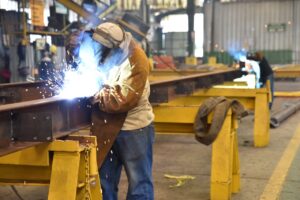 Welder Safety Tips: Avoiding Welding Fumes and Other Health Risks
Welder Safety Tips: Avoiding Welding Fumes and Other Health Risks
Your employer must check your exposure to harmful welding fumes and provide good ventilation, shielding, and special equipment. You can also reduce your health risk by taking safety precautions (see Safety Tips).
Ventilation
A nearby hood can reduce welding fumes near your breathing zone. The hood is considered a type of “local exhaust ventilation.” General ventilation uses roof vents, windows, roof fans, or floor fans to move air throughout the work area, but is not geared to your personal workspace.
Local exhaust ventilation works better than general ventilation, according to one union group (Welding Hazards, AFSCMC). A combination of both types of ventilation may be best. Local exhaust ventilation and self-contained breathing respirators are required by law when some toxic metals are present and a welder works in a small, crowded area with limited access (29 CFR §1926.353).
Personal Protective Equipment
Personal protective equipment includes face shields, helmets, and goggles fitted with special filter lenses or plates (29 CFR §1910.252). Screens or shields should be used to protect people near the welding area from heat or light. Hearing protection includes ear plugs or ear muffs. Personal respirators help with ventilation problems but should be used in addition to local or general ventilation.
If you work in a confined space, you must also be fitted with safety belts, lifelines, and protective gear. A trained helper stays outside the confined space to perform a rescue in case of emergency.
Manganese in Welding Fumes
You may not be exposed to more than 5 milligrams per cubic meter of manganese from welding fumes at any time during the work day. See Manganese in Welding Fumes for more details.
Ways to Reduce Welding Hazards
For more information about your employer’s responsibilities, contact your local union or the Occupational Safety and Health Administration (OSHA), the government agency responsible for setting safety standards in the workplace.
Here are some additional tips and reminders that you may find helpful:
- Know what you are working with. Your employer must show you Material Data Safety Sheets (MSDSs) if you ask for them. These sheets disclose which toxic chemicals may be released during welding using a particular welding rod or material. Reading the MSDSs can help you be better prepared and discourage you from taking unwise shortcuts.
- Use the safest welding method and materials for the job. For example, stick welding makes much fewer fumes than flux core welding, according to the Center to Protect Workers’ Rights.
- Don’t weld on painted parts. Remove the surface coating before you begin welding.
- Try to keep a clean, accessible work area. This can reduce the risk of falls and accidents.
- Keep your face away from the welding plume.
- Try to keep physically comfortable by changing your position periodically.
- Learn all you can about safety. Your employer must provide safety training. Take this training seriously- your health is at stake.
- Protect your family. Your spouse and kids could be damaged by toxins you bring home on your shoes and clothing, so it’s important to put on clean clothes before leaving the workplace. Your employer may also have shower and locker facilities for your use.
OSHA considers welding a hazardous activity. Do all you can to minimize your risk from welding fumes and other dangers.
